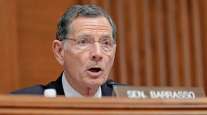Senior Reporter
Stakeholders Pessimistic About Quick Action From Capitol Hill on Highway Funding Bill

This story appears in the May 22 print edition of Transport Topics.
WASHINGTON — Little optimism was heard from podiums and audiences at Infrastructure Week events last week that Congress will pass President Donald Trump’s planned $1 trillion infrastructure funding bill soon, or that the federal government will be looking to public- private partnerships to plug a gaping hole in the Highway Trust Fund.
“We’re moving really slow this year,” Jeff Davis, a senior fellow at the Eno Center for Transportation, told transportation stakeholders at a May 16 Coalition for America’s Gateways & Trade Corridors event.
LIVEONWEB REPLAY: Infrastructure Week Reporter Roundtable
“The statutory deadline for Congress to finalize its own FY 2018 budget was April 15, and they haven’t even started in committee because they’re waiting on the president’s budget, which was due the first Monday in February.”
Davis predicted that the infrastructure bill will have to wait until after Congress “digs itself out of a hole on health care reform,” deals with tax reform, passes the FY 2018 budget by Oct. 1 and finishes heated arguments over future spending levels and the debt limit.
Those sentiments were repeated many times by panelists speaking at the CAGTC event as well as a May 15 public-private partnership event organized by the National Council for Public- Private Partnerships.
Norman Anderson, president of CG/LA Infrastructure and a panelist at the P3 event, said that the state of funding for infrastructure is “drastic and getting worse.”
“It’s been five months into the new administration and nothing’s happening,” Anderson said.
Ed Mortimer, executive director of transportation infrastructure, for the U.S. Chamber of Commerce, was one of the few speakers to express confidence that an infrastructure bill would get passed before the end of the year.
“But the federal government must provide leadership,” Mortimer said.
At the P3 event, executives complained that P3s, although not uncommon in Europe and elsewhere around the globe, are viewed with skepticism by U.S. taxpayers and that the federal government puts up significant barriers to private investors looking to financially back infrastructure projects for everything from water and buildings to roads and bridges.
Foremost among the issues addressed at a three-hour session, “Reality Check: Can P3s Solve All of Our Infrastructure Issues?” were concerns that the White House Office of Management and Budget’s scoring rules for P3s are unfair and that regulatory hurdles take an average of seven years to clear before jobs can start.
Panelists at P3 sessions complained about barriers ranging from the complexity of federal spending authority and a lack of financial expertise by state and local officials to insufficient capital for federal matching funds and risky federal permitting requirements.
But Samara Barend, senior vice president for AECOM Capital, said at the CAGTC event that since 2010 there have been $36 billion in P3 projects in the United States.
“For probably about the past seven or eight years, both in the private and public sectors, we’ve seen a real uptick in the number of projects,” Barend said. “But compared to other places like Canada and the U.K., we’re still quite slow in terms of really developing a market.”
Ananth Prasad, national transportation practice leader at HNTB, said that the federal government needs to streamline the environmental approval process.
“But really, we need to be focused on transformational projects, the needle-mover projects,” Prasad said. P3 projects should “sustain job creation for a long period of time. …We got to figure this situation out. It’s important, whether it’s tolling or fees or gas tax, it needs to be addressed in this context.”
As for the $1 trillion infrastructure bill, Prasad said optimism is “kind of wavering.”




